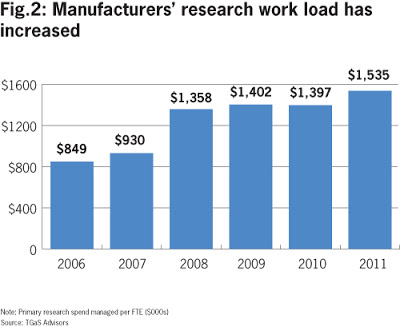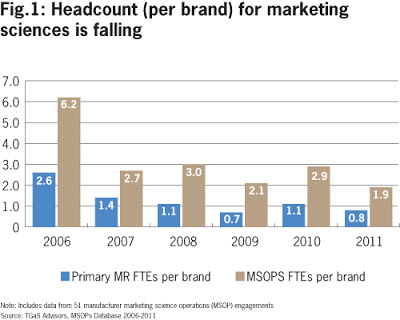The drug industry is laying off people left [brain] (research) and right [brain] (marketing and sales). Market research (MR) — definitely a left brain activity — is currently experiencing a downsizing that will have “implications for those in the trenches,” according to Marc Iskowitz, writing in Medical Marketing & Media (see “State of Market Research: Analyze This“). Iskowitz summarized results of the Pharmaceutical Marketing Research Group (PMRG) Second Annual State of the Industry (SOI) Survey, conducted in collaboration with TGaS Advisors. Full survey results will be available at PMRG’s Annual National Conference.
Here’s some trend data from the survey that documents the downsizing:
“The reasons behind the downsizing are well known to anyone who follows the pharma industry,” notes MM&M. “Brands are maturing and thus requiring less overall analytical support.”
The workload of the MR staff, however, has increased according to Todd Francis, VP and head of commercial support and enterprise marketing for Sanofi US. Francis was quoted as saying “With reduced [research] headcount, [and] the same number of marketers asking the same amount of questions, you become less able to think about what you need to be doing next and more focused on the questions that are being asked.”
But, who exactly is doing this work? Outside vendors are relied upon more and more to do market research. According to Karen Tibbals, former Director Market Research at Schering (Merck), this is stifling innovation in marketing research primarily because of the industry’s preferred vendor system (see “Pharma needs truth tellers, not preferred vendors“). Tibbals now is a Self-employed Consultant, Trainer, Speaker and a Masters of Divinity Student at Earlham School of Religion (see her LinkedIn profile).
Tibbals also writes a soul-searching blog focused on the state of pharma marketing research “because I am concerned about the direction of the field. There have been changes taking place due partly to global economic trends. While I understand the forces behind the trends, I want market researchers to start to think about how they respond to the trends and not just react. I see danger in pure reaction, danger for the future of the market research field.”
“With Finance and its henchmen in Purchasing and HR running pharma’s operations, intangibles such as insight, veracity and innovation are low priorities when it comes to selecting suppliers,” wrote Daniel Hoffman, the author of the Philly.com story cited above. “Finance and its minions claim that such qualities, in fact, don’t really exist because they are not easily quantifiable or amenable to spreadsheet analysis. Absent such characteristics, marketing research becomes a commodity service that the pharmas can retain on a lowest cost basis. Some companies even go so far as to make supplier candidates compete for retainers by means of negative auctions — lowest bidder wins. Since it works for hog bellies and soybeans, why not use it for marketing research?”
“Automation and outsourcing are giving us faster and/or cheaper, but not better,” says Tibbals (see here). “Better has to come from people who are interacting, and thinking. In the effort to cut costs, care has to be taken that what is cut doesn’t affect the ability to improve, to provide more value and to serve as a competitive advantage for the corporations that pay the salaries.”
[Note: PMRG is a Pharma Marketing Network (PMN) advertiser. PMN helps promote PMRG’s Annual Conference. I am not paid to write blog posts such as this one by PMRG or any other advertising partner.]










![6 Digital Tools at the Center of Healthcare Digitalization [INFOGRAPHIC]](http://ec2-54-175-84-28.compute-1.amazonaws.com/pharma-mkting.com/wp-content/uploads/2021/04/6DigitalTools_600px-100x70.jpg)




